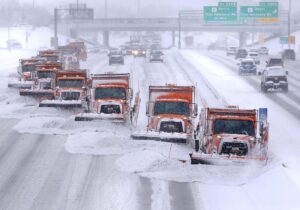
A weather forecast of snow indicates a steady fall of snow. The forecast may be modified by terms such as “light,” “moderate” or “heavy” to indicate the intensity of the snowfall.
The intensity is measured in terms of visibility during the snowfall:
- Light snow — visibility of 1 kilometer (1,100 yards) or greater.
- Moderate snow — visibility between 0.5 kilometer (550 yards) and 1 kilometer (1,100 yards).
- Heavy snow — visibility of less than 0.5 kilometer (550 yards).
A forecast for intermittent snowfall often refers to light snow falling for short durations. No accumulation, or a light dusting, is expected. The National Weather Service defines snow flurries as intermittent light snow. Snow flurries are short durations of snowfall and produce no measurable precipitation, only trace amounts. Snow flurries tend to come from stratiform clouds.
The term “snow shower” refers to a short period of light to moderate snowfall and is characterized by a sudden beginning and ending of the snowfall. Some accumulation is possible. The atmosphere is susceptible to the development of snow showers when the difference between the surface temperature and the temperature some distance above the ground is large.
Snow squalls are brief, intense snow showers accompanied by strong, gusty winds. Accumulation of snow on the ground may be significant during snow squalls.
Blizzard conditions include winds greater than 35 mph with heavy snow or blowing snow. Visibility is poor, less than a quarter of a mile, and these conditions are expected for a period of three hours or more.
Snow is difficult to measure because it can be moved by the wind. Newly fallen snow is reported in inches to the nearest tenth of an inch. The measurement is taken as soon as the snowfall has stopped. Meteorologists use a snowboard — a flat wooden surface -– and measure in a location where drifting does not usually occur.
Steve Ackerman and Jonathan Martin, professors in the UW-Madison department of atmospheric and oceanic sciences, are guests on WHA radio (970 AM) at 11:45 a.m. the last Monday of each month. Send them your questions at stevea@ssec.wisc.edu or jemarti1@wisc.edu.

